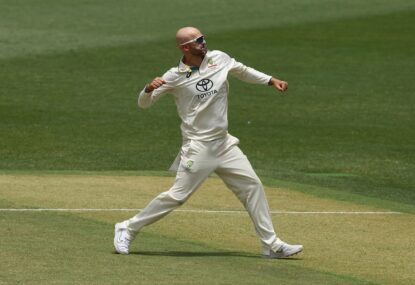This week’s Delhi Test between India and South Africa showed why amid all the changes being made to cricket’s longest form, the draw is one thing that must not be scrapped.
It sounds silly given the fourth Test didn’t end in a draw but rather a hard-fought victory to the host nation.
The fact, however, is that batting for a draw can produce a brilliantly defiant stalemate or, on the other hand, an unforgettable breakthrough victory, as was witnessed only this week.
With a mammoth 481 runs needed for an unlikely victory, and with just over five sessions to be played, the Proteas opted for the stonewall approach.
Ball after ball, hour after hour, session after session, Ravi Ashwin off-spinners were smothered into the dire Delhi dustbowl.
The odd loose delivery drifting down leg that would usually be whipped for four behind square, would be dead-batted to a short midwicket.
The statistics were astonishing:
Hashim Amla 25 off 244 at 10.24.
A.B. de Villiers 43 off 297 at 14.47.
Faf du Plessis 10 off 97 at 10.30.
No one in the history of Test match cricket has soaked up more deliveries as the defiant de Villiers for a score below 50.
The visitors batted for 859 balls – that’s 143.1 overs – in their second innings, for a remarkable 790 dots.
And that was what made for such compelling viewing.
Very little is better for the appeal of Test match cricket than seeing a side that has been totally outplayed fight tooth and nail for a day and a half as they strive to save a Test.
The fielders surround the bat like vultures.
Every thick edge that drops just short of bat-pad is accompanied by a longer-than-usual ooh or ah.
The unyielding character of the players is brought to bear.
And as we saw this week, the match can hang in the balance in the shadows of stumps on day five.
Will de Villiers and the tail-enders survive? Or will the fingers of Ashwin and Ravindra Jadeja tweak the hosts to victory?
Both results would have made for epic scenes.
Some of the most memorable Tests in history have come from sides batting for a draw and holding on or, on the other hand, the bowling side clinching victory in the dying moments.
Cast your memory back to Old Trafford in 2005 when England set Australia the colossal task of chasing 423 runs to win in just over a day’s play.
Ricky Ponting played the innings of his life with a knock of 156 off 275 deliveries, although the falling of wickets around him eventually called for the ‘shut-up shop’ approach.
The task became all the more harder when the red leather caught Ponting’s glove down the leg side and with the match on a knife’s egde, Glenn McGrath joined Brett Lee at the crease.
At 9-354, the pair had four panicky overs to survive, of which they did amid unforgettable scenes.
Three years later at the SCG in the similar scenes of India striving for survival against Australia, we witnessed the opposite result.
With a draw appearing the only feasible outcome, Ponting threw Michael Clarke the ball in the dying stages.
In his second over, Pup weaved his left-arm orthodox magic to take wickets eight and nine and then three balls later snatch the wicket of Ishant Sharma to win the match for the baggy green.
Extraordinary viewing.
However as the recent WACA Test between Australia and New Zealand showed, some matches can fizzle out.
The wicket is lifeless and the two sides just bat, and bat, and bat some more.
The averages of batsmen only inflate even more in an era already dominated by the men wielding the willow, the bowlers endure session upon session of punishment in sweltering conditions and there is little excitement in the match.
There were six centurions at Perth, two of whom scored double tons, and one of whom came within just 10 runs of a maiden triple hundred in Ross Taylor.
To put things into perspective, Warner’s 253 is the second-highest individual score in history to be surpassed by an opposition player in the same Test. The highest is Aravinda de Silva’s 267 surpassed by Martin Crowe’s 299 at Wellington in 1991.
It called for former Australian opener Justin Langer to say that draws should be canned from both Test match and first-class cricket.
“If we take the draws out, and play a bit of day-night cricket, it’s all good for the game,” Langer said.
“Usually sport is about winning or losing, it’s not about drawing.”
What one must not forget, however, is the fact a Test can last five days and still end in a draw is something that makes the great game of Test cricket so unique.
Additionally, having the precision of judgement to declare an innings closed at the pivotal moment is an art of captaincy that would be lost if the draw was to be abolished.
Besides, who doesn’t fancy half an hour of pre-declaration fireworks?
We must not throw the baby out with the bathwater.
The gripping nature of a Test that hangs in the balance, one side batting for survival as the other fights tooth and nail for 10 wickets, offers a wealth of appeal to Test match cricket.
It’s like an enthralling game of chess in which one player finds a way to salvage a stalemate despite having been completely outplayed.
In light of the inception of day-night and pink-ball Test cricket, the evolution of the DRS and the very real possibility that the toss will soon be a thing of the past to combat home advantage, it is clear that cricket’s longest form is undergoing a lot of change.
This week’s Delhi Test reminded us that amid all this change, the draw is one thing that must remain.
A victory for South Africa would have been a triumph of the human spirit and survival at its finest, whereas what we saw was an epic clinching of victory in the fourth Test and it stemmed from the defiance in batting for a draw.






































































































